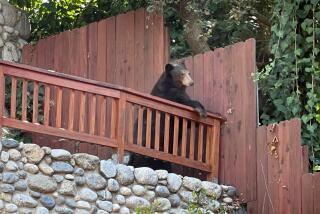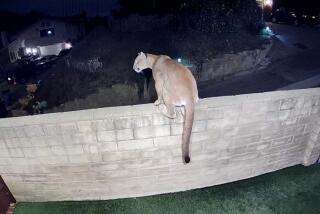Creepers’ peepers: Why animals’ pupils have different shapes
There’s a reason why the domestic cat’s pupil has its distinctive, vertical slitted shape and the grazing goat’s its horizontal, flattened look. In both cases, the eye’s shape has evolved to help its owner navigate everyday life. The cat needs to be able to hunt at night with precision; the grazing goat, to detect predators and flee, if need be.
So concluded a team of scientists at UC Berkeley and the University of Durham in England when they analyzed the eyes of 214 terrestrial species, hoping to answer a deceptively simple question about creepers’ peepers: Why do animals’ eyes have pupils of different shapes?
The question occurred to UC Berkeley vision scientist Martin Banks almost by accident, he said, as an outgrowth of earlier work in human vision and perception that looked at the relationship between stereoscopic vision -- the brain’s ability to combine images from the right and left eye -- and blur, and how the human vision system uses both to estimate distances.
As part of that research, Banks and students had written briefly about “odd-shaped pupils” in the animal kingdom -- specifically, the vertical slits in the eyes of domestic cats and other small ambush predators, which help those animals pick up on the same distance cues (stereopsis and blur) to gauge how far they must pounce to capture would-be prey.
The new study of animal pupils, published Friday in Science Advances, expanded on that train of thought. Working with a new team of collaborators, Banks took a step back and looked at a wide variety of animals, cataloging which ones had what pupil shapes and taking note of the ecological niche the animals occupied.
Generally, nocturnal or polyphasic ambush predators (which sleep in several bouts in a day) had vertical, slit-shaped pupils while predators who are active during the day had round pupils. Herbivores, in the meantime, had horizontal pupils.
NEWSLETTER: Get the day’s top headlines from Times Editor Davan Maharaj >>
Just as the team had analyzed how the vertical-slit shaped pupil conferred an advantage to nocturnal hunters, they decided to probe how other pupil shapes helped other beasts. Take the horizontal pupils of the grazers. In the past, others, including a Berkeley researcher named Gordon Walls in the 1940s, had suggested that horizontal pupils provided a kind of panoramic vision that helped goats, sheep and other herbivores look out for predators.
Constructing a computer model of a sheep’s eye and simulating light moving through it, Banks and his colleagues showed that the conjecture was correct. The horizontal pupil increases visibility in the horizontal plane and reduces “dazzle” from above. It also decreases blur when a prey animal has to peer ahead out of the corner of its eyes to run from a predator.
An analysis of the relatedness between the surveyed species showed that pupil shape had evolved independently multiple times, tracking along as animals moved into new circumstances.
“If an animal becomes nocturnal, they’re likely to develop a vertical pupil, if they become diurnal, they have a round pupil. It’s not just random,” said William Sprague, a postdoctoral researcher at UC Berkeley and a coauthor on the paper. “The changes are associated with their ecological niche.”
During less technical interludes during the research process, the team spent time in zoos and on farms watching animals with horizontal pupils as they grazed, observing that the animals’ pupils maintained the horizontal orientation with the ground even as they bent their heads down to eat. Because the eyes are on the sides of their heads, this means that one eye pitches in a clockwise direction while the other pitches in a counterclockwise direction, Banks noted.
They did not find that noted in the scientific literature, but said they doubted they were the first to discover this.
“There’s no way mankind went through centuries with these animals and no one ever said this,” Banks said.
For more on science and health, follow me on Twitter: @LATerynbrown
ALSO:
Deadly Nepal earthquake was not the ‘Big One,’ scientists say
DNA proves it: African ‘golden jackal’ is really a golden wolf
Spice up your diet for a longer life, study suggests







